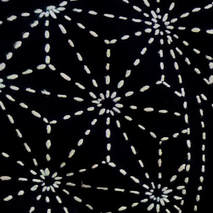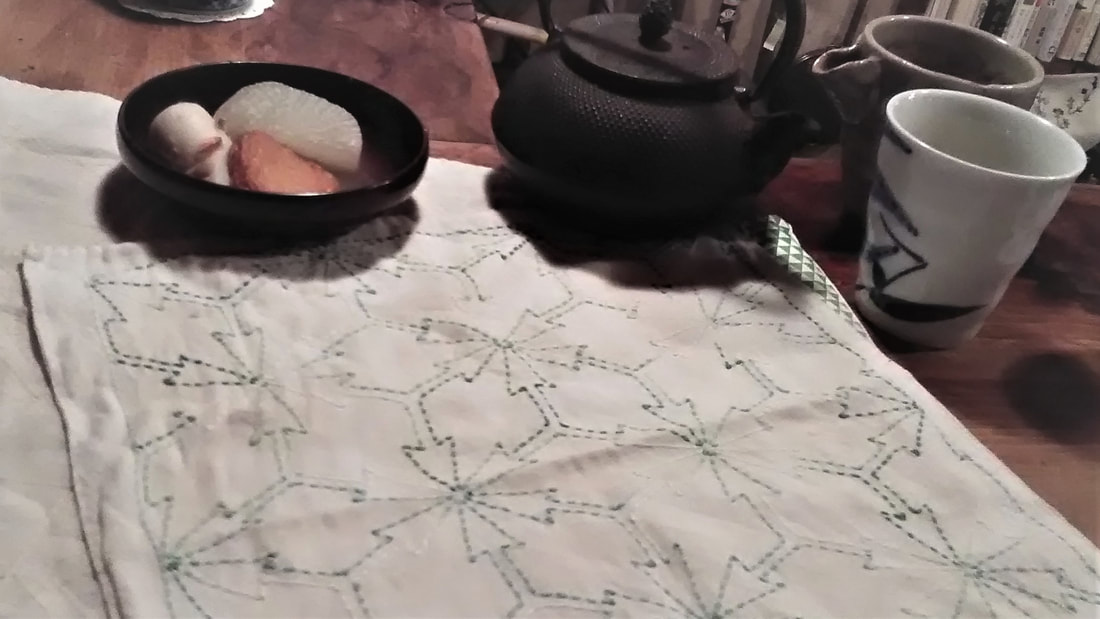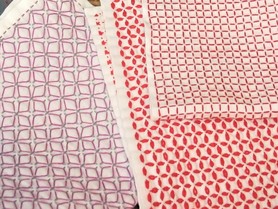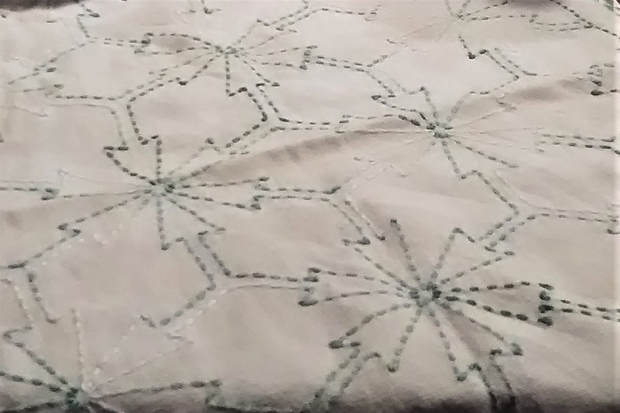|
When I started doing sashiko it wasn’t long before I learned the word fukin. All the books and kits seemed to feature fukin, which was obviously a square cloth approximately thirty something centimetres in size, stitched with a variety of patterns. For a long time I was so absorbed in grappling with the stitching and patterns it didn’t occur to me to wonder exactly what fukin were. But then it struck me: What the heck are they? I didn’t see them available ready-made in shops, or having any specific function in contemporary Japanese daily life. Now I can tell you what I’ve learned about fukin since then. Although there are regional variations in patterns and function, fukin had many uses in the days before towels became widespread, both practical and decorative. For example, they were used as placemats for the individual tray tables that people ate from in the days before sitting around a table to eat became the custom from around the 1920s onwards. They were also used to cover teacups, cooking implements, or as a simple decorative mat.  Hanafukin (literally ‘flower cloth’), as the fukin stitched on bleached cotton are called, were part of women’s lives in many ways. Daughters in samurai families learned to sew them to acquire such desirable mental attributes as perseverance and patience, whereas girls in farming families, learned to make them out of necessity, and at night, when all the other chores were done, women would sit around and do the sewing together. If a woman became widowed, other people might commission her to make hanafukin as a way of discreetly giving financial support. Mothers sewed hanafukin for their daughters to take when they went as a bride to live in another family. I suspect this is how the word hanafukin originated, since the word for bride is hana yome. From the time her daughter was born, a mother would begin to make hanafukin stitched with various patterns representing good wishes for health, happiness, and different auspicious occasions and seasonal events. Stitching that was decorative in purpose was known as moyozashi (pattern sashiko), whereas stitching that was designed for practical purposes was known as jizashi (‘ground’ sashiko). Jizashi stitching, which is as resilient as it is beautiful, was used for mending clothes, reinforcing cloth to make it warmer, or making covers or pockets for tools. A new bride would use the hanafukin her mother had given her as a model for each sewing task she needed to perform. In this way hanafukin were a practical sign of a mother’s love for her daughter. A few hours after writing the above, I found myself in a tiny backstreet bar in Tokyo drinking shochu spirits in hot tea and, as often happens with me, not surprisingly, sashiko came up in the conversation. When I mentioned hanafukin, the bar owner immediately brought out two to show me that she had received from her own mother. I was thrilled to see these well-used and loved hanafukin, which made me feel like going straight home and getting started on stitching for my own daughter! I am indebted to Hiroko Kondo’s book Akita ni tsutawaru oiwai no hari shigoto: Yomeiri dogu no hanafukin (Traditional congratulatory needlework in Akita: Hanafukin, a bride’s trousseau), Kurashi no techosha, 2013 - Amazon Japan affiliate link here. It is a wonderful reference and the patterns in this book are stunning, I will introduce it in more detail at a later date.
5 Comments
Carolyn
10/17/2017 04:38:06 pm
How interesting. I have three daughters and would love to do this for them.
Reply
Alison
10/17/2017 05:04:59 pm
It's a lovely concept, I think.
Reply
Dee
10/19/2017 11:39:06 am
My dear friend gave my a beautifully stitched hanafukin when I moved from Japan last year and she even stitched a で into one corner. I now use it to cover the toaster in the kitchen & every time I see it I think of her. She had a few hanafukin including some her grandmother had made for her & always says they’re something to be used not put away in a cupboard for good.
Reply
Alison
10/19/2017 02:48:32 pm
Thank you for sharing that, Dee! Proof indeed of the special role hanafukin have in women's lives.
Reply
Leanne Ogasawara
9/13/2021 06:14:17 am
These are so beautiful! My grandmother and my mom embroidered all of their plain white dish towels. I have always loved that...in that case, they left the back as is and so you could see the back of the embroidered towel...the kit instructions are ambiguous. but it seems that an extra blank part is put as a panel back so the backside of the embroidery can't be seen? But if that is not quilted together how does it work? Does my question make sense ?? :)
Reply
Leave a Reply. |
Watts SashikoI love sashiko. I love its simplicity and complexity, I love looking at it, doing it, reading about it, and talking about it. Archives
September 2022
Categories
All
Sign up for the newsletter:
|





 RSS Feed
RSS Feed



